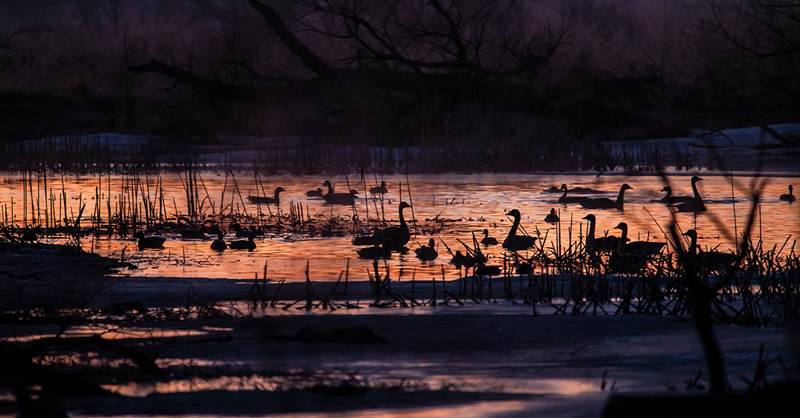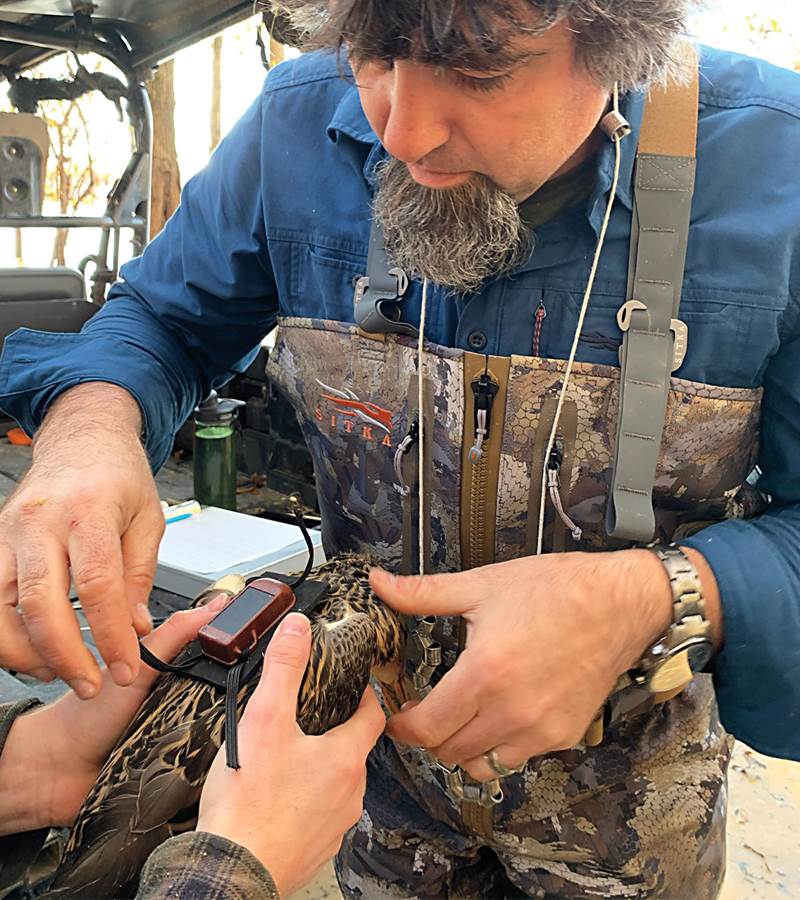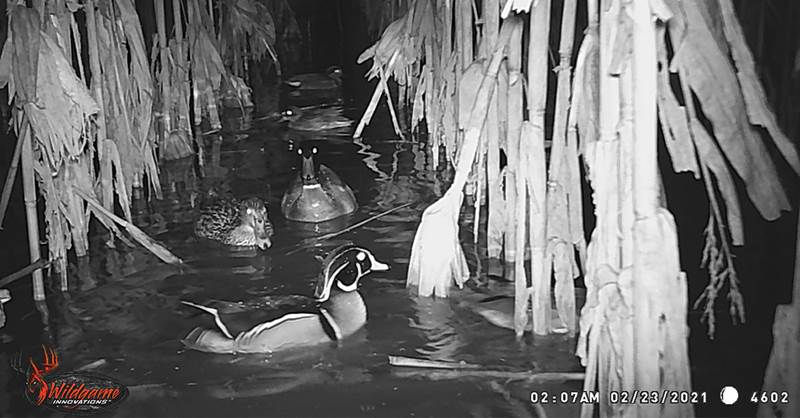Understanding Waterfowl: Night Moves
New research reveals that ducks lead active lives after dark
New research reveals that ducks lead active lives after dark
By Heath Hagy, PhD, Bradley Cohen, PhD, and Douglas Osborne, PhD
.jpg)
If you have spent any time with friends in a duck blind, the question "have the ducks gone nocturnal?" has surely been batted around on more than a few occasions. The nighttime behavior of waterfowl has been a favorite topic of discussion among waterfowlers for more than 100 years. Some people believe that ducks feed all night, especially on carbohydrate-rich hot foods, and sleep all day in sanctuaries. Others adhere to the belief that ducks make two foraging flights each day, one in the morning and one in the evening, and that the birds can be outsmarted if hunters are patient enough to wait them out.
What waterfowl actually do at night and where they go remained largely a mystery until fairly recently. Advances in tracking technology and night vision optics have revolutionized our ability to study duck behavior after dark. From radio, cellular, and satellite tracking devices to radar platforms, a wide range of technology has revealed the fascinating things that ducks do while most of us are sleeping.
As many hunters have long suspected, ducks are surprisingly active at night. In fact, the ducks that you watch flying over while picking up your decoys after an evening hunt are likely just starting their day. Movements of ducks are typically greatest during crepuscular periods: the half hour before first light and the half hour after dusk. Whether ducks stay out all night or come home by curfew varies by species and location. Studies in Louisiana, Illinois, Texas, and California have shown that northern pintails, mallards, and American green-winged teal can make evening foraging flights of up to 30 miles to feed in crop fields during fall and winter, with most of those movements occurring after shooting hours have ended.

Most ducks spend all night in one spot, feeding, courting, preening, and performing basic maintenance behaviors until just before sunrise, when they move to resting areas.
More recent research conducted in Arkansas, California, and Tennessee shows that, surprisingly, ducks do not hop between foraging areas after dark. Instead, they leave sanctuaries early in the evening, and most of the birds spend the night in one spot until just before sunrise, when they move back to resting areas. Research has also revealed that some species feed more at night than during the day, and that birds of the same species do different things in different locations. In fact, some studies suggest that mallards are as active at night as they are during the day, spending much of the nighttime courting, preening, and performing basic maintenance behaviors. The birds do indeed sleep at night too, just as they do during the day.
Researchers have also discovered that ducks develop daily patterns of activity and movements associated with particular wetland types. For example, wintering mallards studied in Arkansas primarily used forested and seasonal emergent wetlands during the day and then moved to flooded croplands at night. Similarly, green-winged teal and gadwalls in Illinois used large wetlands and lakes at night during spring but switched to small emergent wetlands, managed moist-soil units, and other vegetated wetlands during the day. Forested and shrub-scrub wetlands provide thermal cover and protection from aerial predators, whereas moist-soil wetlands and flooded agricultural fields contain high-energy food sources. Although ducks certainly use agricultural fields, including crops planted and left standing by hunters, they may not use them extensively during the day until later in winter, when colder weather increases their energy demands.

Wintering ducks also show higher levels of philopatry (returning to certain areas) than previously thought. Recent research has revealed that many ducks return to the same wintering areas year after year, and that once they settle in an area following the fall migration, they often remain there all winter, even when it gets very cold. Ongoing studies in Arkansas and Tennessee have found that mallards typically move less than four miles a day and generally stay within a 15-square-mile area throughout winter. Researchers have documented equally small home ranges among northern pintails in California, gadwalls in Alabama and Louisiana, green-winged teal in Illinois and Arkansas, and mottled ducks in Georgia and South Carolina.
Decades of research have taught us that ducks are extremely adaptable and can learn quickly about their environments. Although we have long thought that ducks bounce around vast regions during fall and winter, it is becoming apparent that many ducks show high fidelity to relatively small areas once they arrive on the wintering grounds. Consequently, week-long cold-weather events with snow and ice may not be enough to move mallards farther south after they have settled on a preferred wintering area; it is probably more energetically costly and risky to move to a new, unknown area than to hunker down during a relatively short freeze.

Night vision optics and other technologies are helping researchers understand what ducks do after dark.
New data is also showing how ducks adjust to predation risk, both from natural predators and from humans. Research has revealed that the birds learn very quickly to use sanctuaries during the day when avian predators are watching and duck blinds are filled with people. Mallards prefer sanctuaries that are completely closed to hunting over public hunting areas that are closed during the afternoon or on certain days of the week. Sanctuaries on public land are often some of the first areas to be flooded in the fall and early winter, providing food and other habitat resources to attract migrating ducks. These resting areas undoubtedly serve as hubs from which ducks radiate out across the landscape, providing opportunities for hunters in surrounding areas. One thing that has become increasingly clear is that removing sanctuaries from a particular area is unlikely to redistribute ducks onto nearby hunted lands. Instead, it is more likely that eliminating traditional sanctuaries will encourage ducks to leave the area entirely.
Hundreds of studies on the behavior, movements, and habitat preferences of ducks over the last century have taught us that it is challenging to predict duck behavior and habitat use, especially at night. Thus, hunters must focus on what they can control and marvel at what they cannot. To see more ducks from our blinds in the morning, we must ensure that our hunting areas are just as attractive to ducks during the day as they are at night. Providing diverse food resources, cover from inclement weather and predators, and isolation from human disturbance are all important pieces of the habitat puzzle for wintering waterfowl.
Dr. Heath Hagy is waterfowl ecologist for the US Fish and Wildlife Service National Wildlife Refuge System, Southeast Region; Dr. Brad Cohen is assistant professor of wildlife ecology at Tennessee Technological University; and Dr. Douglas Osborne is professor of wildlife management at the University of Arkansas at Monticello and director of the Five Oaks Ag Research and Education Center.
Ducks Unlimited uses cookies to enhance your browsing experience, optimize site functionality, analyze traffic, and deliver personalized advertising through third parties. By continuing to use this site, you agree to our use of cookies. View Privacy Policy